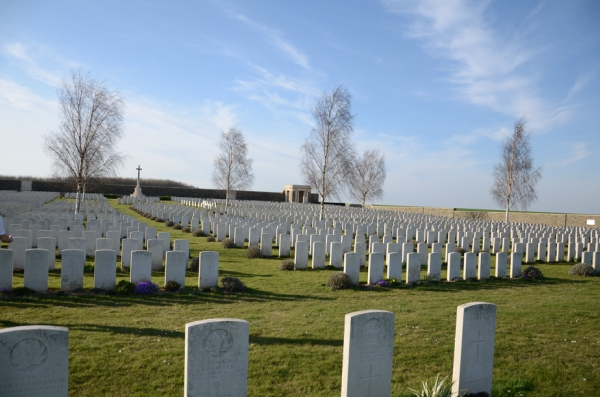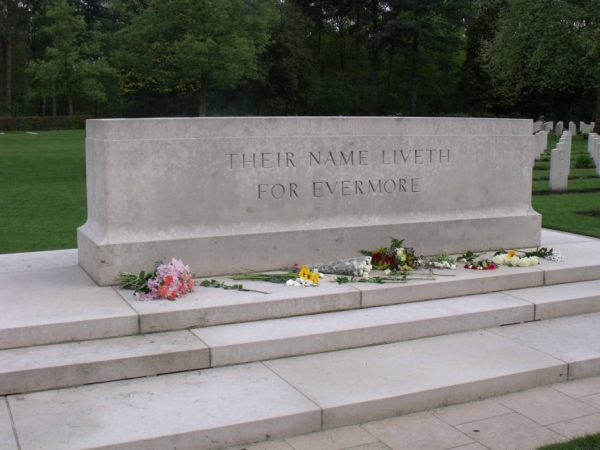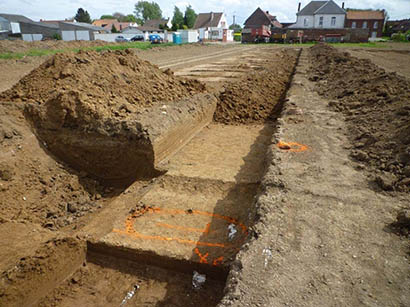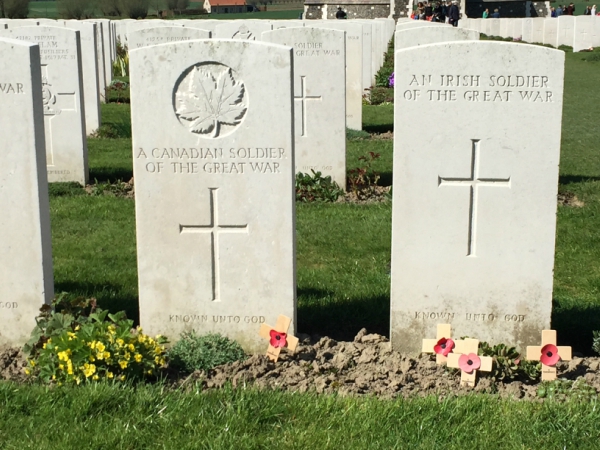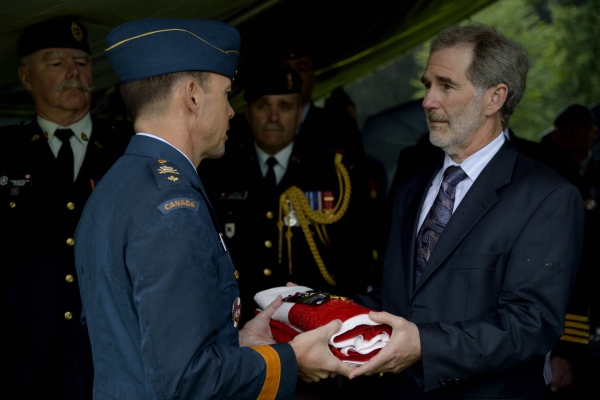Casualty Identification Program
The Casualty Identification Program works to identify newly found skeletal remains and pre-existing unknown graves of Canadian service members from:
- the First World War
- the Second World War
- the United Nations Operations in Korea (Korean Conflict)
When skeletal remains are discovered, the Program attempts to identify the Canadian service members and provide them with a proper military burial. When historical research suggests a Canadian occupant of an unidentified war grave, the Program attempts to confirm the identification and, if successful, requests a new headstone with the service member’s name.
On this page
- Why we do it
- Equality in Death
- Identification process
- Discovery of remains
- Historical research
- Anthropological analysis
- Forensic odontology
- Stable isotope analysis
- Genealogical research
- DNA testing
- Artefact conservation
- How can you help?
Why we do it
The Department of National Defence officially established the Casualty Identification Program in 2007 to respond to an increasing number of discovered human remains of the more than 27,000 Canadian war dead with no known grave from the First World War, the Second World War, and the United Nations Operations in Korea (Korean Conflict). In 2019, the Program began to formally confirm the identification of “unknown” graves in response to an increasing number of historically-based research reports received from external researchers.
During and in the immediate aftermath of both world wars, Canada’s Grave Registration Units and the Imperial War Graves Commission (now called the Commonwealth War Graves Commission) attempted to identify and provide Canadian service members with proper burials. Whenever they were unable to identify a service member, they were buried and commemorated as an “unknown.” Meanwhile, the service members with no known grave were commemorated on memorials to the missing.
Although active searches for the remains of Commonwealth soldiers were suspended after 1921, Commonwealth countries continue to attempt to identify the remains of missing service members found in the present day, and identify service members who are buried under an “unknown” headstone. In Canada, this work is done by the Casualty Identification Program.
Investigations for skeletal remains begin when they are discovered and identified as Canadian war dead because of an artefact that identifies Canada, or the military history of the area of discovery. The Casualty Identification Program uses a number of historical and scientific research methods to identify the remains.
Investigations for “unknown” graves begin when external researchers submit detailed research reports that suggests the identity of an “unknown” grave as belonging to a Canadian war dead. The Casualty Identification Program then conducts extensive historical research to confirm the findings and possibly identify the grave.
When the Casualty Identification Program’s investigation is successful, identified human remains are buried with a name, by their unit, and in the presence of their family. When an identification of an “unknown” grave is successful, the headstone is replaced with one that fully identifies the individual and a small rededication ceremony is held.
Each case has its own challenges. New technologies and better access to historical documents continue to improve the Program’s ability to identify Canada’s missing service members.
The Casualty Identification Program promotes a strong sense of continuity and identity within the Canadian Armed Forces. The attempt to give a name to each missing Canadian military fatality is a very important goal for the Canadian Armed Forces.
Equality in Death
As a founding member nation of the Imperial War Graves Commission, Canada respects the policies of the present day Commonwealth War Graves Commission. (CWGC).
The final report of the Imperial War Grave Commission in 1918 signed by all members of the Commonwealth presented a common view opposed to repatriation of war dead. This policy affirmed the commitment to the equal treatment of all war dead. The report noted that these cemeteries “in foreign lands would be the symbol for future generations of the common purpose, the common devotion, the common sacrifice of all ranks.” Sir Robert Borden, Prime Minister of Canada 1911 to 1920, was a key supporter of the policy saying, “it is entirely appropriate that among the ranks of the dead there should be no distinction.”
Repatriation would also be against the spirit of land offers to preserve the war dead in perpetuity from France, Belgium, Italy, Greece and many others.
After the Second World War, nations where fighting took place once again offered land for war cemeteries.
Canada changed its policy against the repatriation of war dead in July 1970. Canadian Armed Forces personnel killed overseas after 1970 have been repatriated to Canada. Canada continues to respect the previous non-repatriation policy for the remains of service members killed on operations before 1970.
Identification process
A number of disciplines help the casualty identification process, including history, archaeology, anthropology, laboratory sciences, forensic odontology, genealogy, and the conservation of artefacts.
The Casualty Identification Program attempts to identify all discovered Canadian remains. Unfortunately, limitations can prevent a positive identification. If historical research and material evidence do not link the discovered remains to a time, place or specific military unit, the list of potential candidates can be in the hundreds or even thousands.
When discovered skeletal remains cannot be identified, the remains are buried as an unknown or unknown Canadian service member. As human remains cannot be exhumed once buried with a Commonwealth War Graves Commission headstone, the Casualty Identification Program collects all available information (including DNA profiles) in the hope that evidence uncovered in the future may positively identify an already buried soldier. In that case, a change of headstone would take place.
Simultaneously, the Casualty Identification Program attempts to identify Canadian war dead who have already been buried but who were not identified following the wars. Such cases are based on partial identifiers on the headstone such as rank, date of death, or military unit, then supported with archival records such as war diaries, personnel files, correspondence, and Concentration and Exhumation reports. Unfortunately, sufficient historical evidence is not always available for every grave. When a grave cannot be identified, no change of headstone takes place though records of the file are kept in case new evidence ever comes to light.
Click on the links below to read more information on the steps that can be included in an investigation.
Discovery of remains
Human skeletal remains of war dead are discovered during construction projects, road works, archaeological digs, and farming activity, especially near known battlefields. Artefacts are often found with the remains and become material evidence in our investigations.
Military artefacts include personal military identifiers (identity discs and items with service numbers), insignia (buttons or badges that identify a unit or squadron), and military equipment that gives evidence as to the nationality of the remains and time period of death.
Personal items, such as rings or watches, are sometimes found with the remains and may give clues to the service member’s identity.
Historical research
The location of the discovery and associated artefacts allows DHH historians to provide a historical background to the events leading to the service member’s death.
From these events, they can determine the service member’s unit or aircraft. Historians determine the number of possible candidates using lists of missing service members, grave registration records, personnel records, and unit war diaries. Medical and biological information for each candidate is collected and passed on to the forensic anthropologist.
Anthropological analysis
Each set of skeletal remains is examined using anthropological methods. The anthropological analysis produces a biological profile of the individual: sex, age-at-death, ancestry, height, pathology (disease), and trauma (injury).
The biological profile is compared to the list of potential candidates created by the historian and will produce a smaller list of candidates based on age-at-death and height. The service members’ medical and biological information collected during the historical research can also help reduce the number of potential candidates.
During the anthropological analysis, bone and/or teeth samples are collected and brought to Canada for possible use in DNA and stable isotope analysis.
Forensic odontology
Members of the Royal Canadian Dental Corps’ Canadian Forces Forensic Odontology Response Team regularly support the Casualty Identification Program. Teeth and jaws can be unique to an individual and used to identify remains. If dental records are available, the forensic odontologists are able to make comparisons that may lead to identification.
Stable isotope analysis
Stable isotope analysis can be used to lower the number of potential candidates by revealing where the service member spent their childhood based on the chemical composition of their tooth enamel. The body absorbs oxygen from water and food over a lifetime. The amount of absorbed oxygen isotopes will be different based on geography. Because the values of these oxygen isotopes have been recorded in a global database, they can be used to show where someone has lived.
Oxygen isotopes are included in the enamel of teeth during its development. Since the chemical composition of dental enamel does not change during one’s lifetime, analysis of teeth can provide geographical information on an individual’s early years of life.
Historical research can determine where each potential candidate lived, including their place of birth. This information is then compared against the results of the laboratory analysis to lower the number of potential candidates.
Genealogical research
Genealogical research is used by the Casualty Identification Program to locate family members of missing service members who are able and willing to give a DNA sample. Participation in the investigation by family members is voluntary.
DNA testing
DNA analysis is used to identify skeletal remains and exclude potential candidates. DNA samples collected from the skeletal remains are compared with samples from family members to see if their DNA profiles are from the same familial lineage.
The Casualty Identification Program typically uses mitochondrial DNA (mtDNA) to identify remains which is passed unchanged from mother to child. Mitochondrial DNA survives well and is very stable over many generations, but its stability may also lead to similar profiles in people who are not closely related which can sometimes create false positives. Even with its limitations, mtDNA is a very useful tool that can help to establish parentage that goes back many generations.
The Casualty Identification Program also uses a type of nuclear DNA called Y-chromosome short tandem repeat (Y-STR). Y-STR DNA is passed from father to son and is genetically stable, but does not survive well in skeletal remains. Unfortunately, some samples from the remains do not provide a Y-STR sample that is suitable for comparison, which means this method cannot always be used.
Both types of DNA are a very reliable way to exclude potential candidates. One or both types of DNA can be used in an investigation to try to identify the remains by including the candidate as being from the same lineage and/or excluding other candidates.
Artefact conservation
The Canadian Conservation Institute provides conservation services to the Casualty Identification Program. A number of artefacts, including identification discs, have been treated and restored by the Canadian Conservation Institute. In some cases, the restored artefacts proved to be imperative in achieving a positive identification.
Personal artefacts are returned to the next-of-kin and provide a memento to the family remembering the fallen.
How can you help?
If you have a relative that is missing from Canada’s efforts in 20th-century wars and would like to provide your contact information, we invite you to register with the Casualty Identification Program. Once registered, relatives may be contacted with a request for additional familial information. Personal details will not be released or used for purposes other than the identification of missing Canadian soldiers unless express permission is granted.
Information about casualty identification
- Roll of identified casualties
- How the cemeteries were designed
- Order in Council P.C. 1970-6/1254, policy on repatriation of war dead
